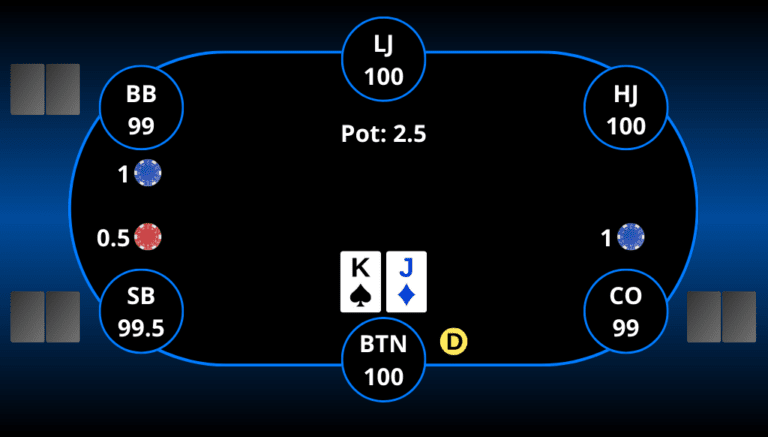
Poker positions
In Texas Hold’em poker, ‘position’ refers to the order in which players act in a hand. The positions closest to the dealer button are…

One or more opponents have entered the pot by calling the big blind. This is a weak move that is not recommended (except in SB in MTT and sometimes after someone has limped before you). For more information, see Unopened pot. Limpers are one of your best sources of income in lower stakes poker. Limpers are one of your best sources of income in lower stakes poker. Find out how to win money from limpers!
Limpers are one of your best sources of income in low stakes poker. Since limping is generally a weak move it is almost exclusively done by bad players.
Since limping is not part of a GTO (Game Theory Optimal) strategy you will not find exact solutions against limpers. This text is based on general recommendations and experience.

Bet sizing
Recommended raise size is 3bb + 1 bb per limper for online games and an extra 1bb when in the blinds. For live play it is recommended to add another 1 bb or possibly more. In general you want to isolate one limper or make them all fold (iso-raise). If you need to increase your raise size to achieve the goal you should also tighten up your range.
When to raise
Before considering the range we want to raise with we should ask ourselves:
In general, if there is a good chance you can get everyone to fold preflop or on the flop you can open wider. If there is a high risk you will be re-raised preflop, you need to raise tighter.
When you are in position to the limper(s) a recommended default raise range is to use the open raise range from the position before your current position. For example, if you are in the button you raise with the cut-off open raise range.
When you are out of position to the limper(s) a recommended default raise range is the 3-bet range you would use against the first limper if they had raised. This might sound tight, but when it comes to other playable hands it is often better to call when in the small blind and check when in the big blind.
When to call behind (overlimp)
For most part it is better to try to iso-raise a weak player and put pressure on them. But in some cases limping behind (overlimping) can be preferred:
It is challenging to memorize all the different charts just by looking at them. It is also hard to know if you remember correctly. We strongly recommend practicing preflop ranges in the preflop exercise to help you commit them to memory and get feedback on mistakes.

In Texas Hold’em poker, ‘position’ refers to the order in which players act in a hand. The positions closest to the dealer button are…

When only the blinds are in the pot it is called unopened. You normally start with a raise, not a call (limping). Some of the reasons are…

Bankroll management is one of the most important topics for aspiring poker players. It is the discipline that helps you avoid going…
| Cookie | Duration | Description |
|---|---|---|
| cookielawinfo-checkbox-analytics | 11 months | This cookie is set by GDPR Cookie Consent plugin. The cookie is used to store the user consent for the cookies in the category "Analytics". |
| cookielawinfo-checkbox-functional | 11 months | The cookie is set by GDPR cookie consent to record the user consent for the cookies in the category "Functional". |
| cookielawinfo-checkbox-necessary | 11 months | This cookie is set by GDPR Cookie Consent plugin. The cookies is used to store the user consent for the cookies in the category "Necessary". |
| cookielawinfo-checkbox-others | 11 months | This cookie is set by GDPR Cookie Consent plugin. The cookie is used to store the user consent for the cookies in the category "Other. |
| cookielawinfo-checkbox-performance | 11 months | This cookie is set by GDPR Cookie Consent plugin. The cookie is used to store the user consent for the cookies in the category "Performance". |
| viewed_cookie_policy | 11 months | The cookie is set by the GDPR Cookie Consent plugin and is used to store whether or not user has consented to the use of cookies. It does not store any personal data. |